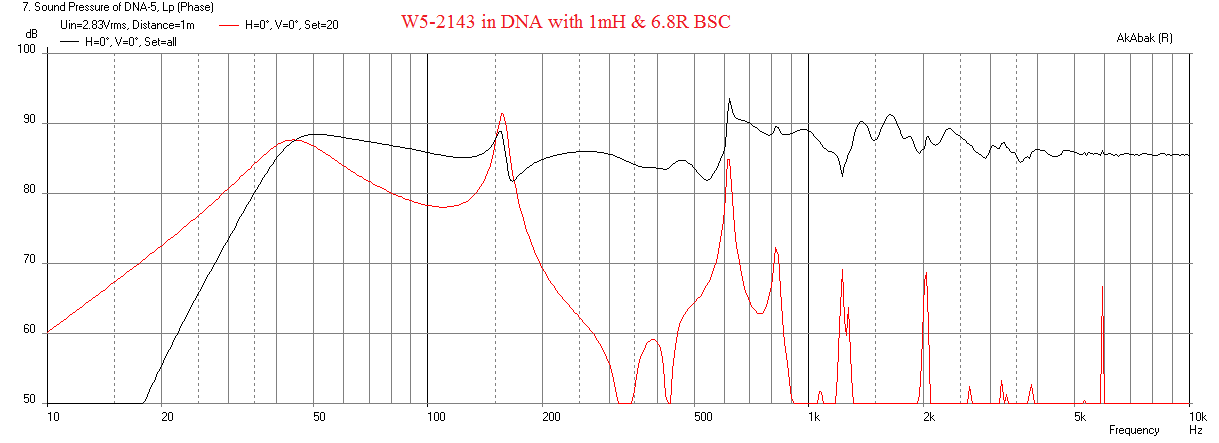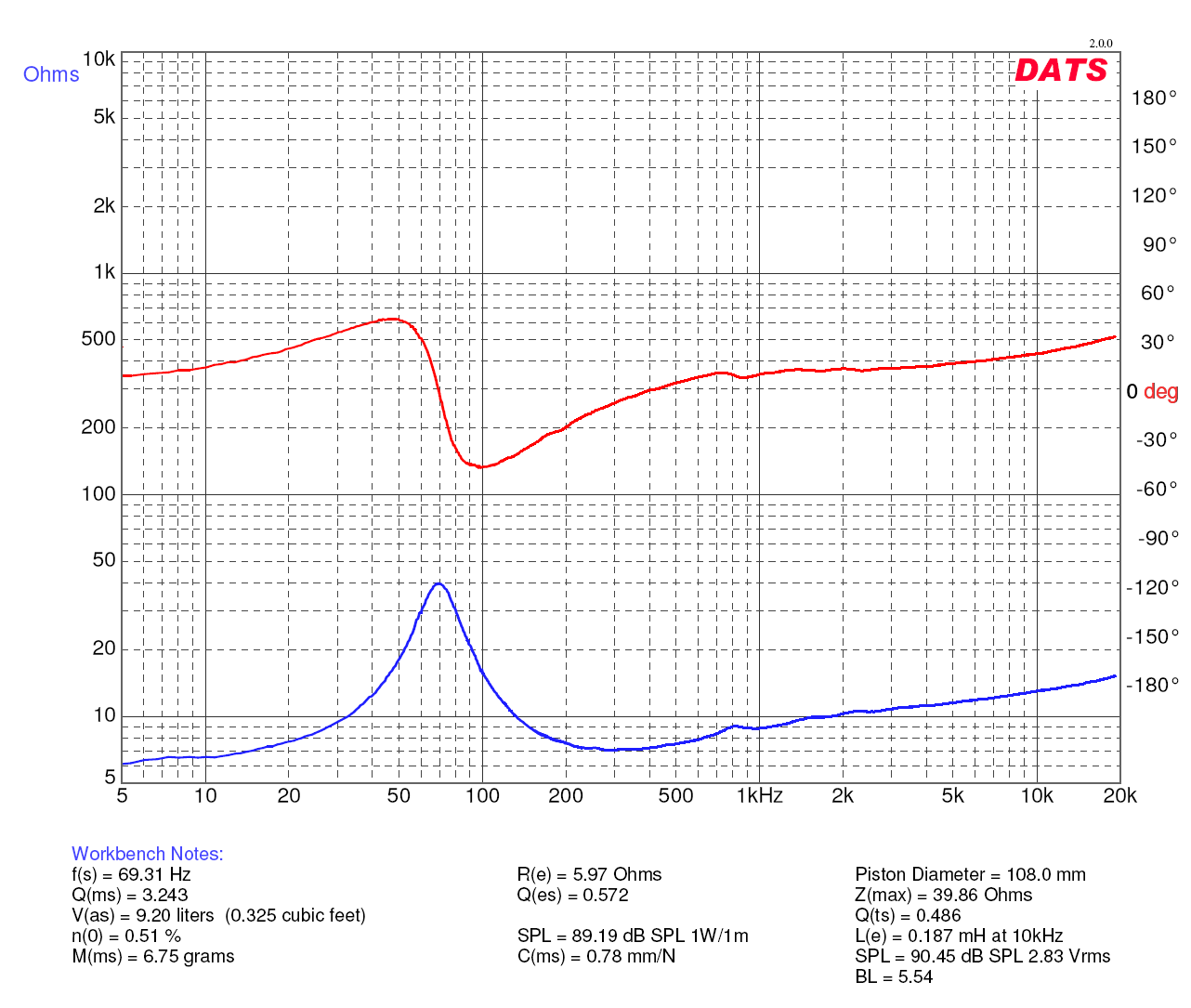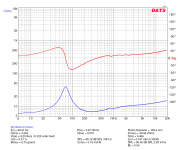That's what you might think right? You can't take HornResp graphs literally that's why it is a bit hard to interpret them if you lack references. I used HornResp just to highlight the differences between the DNA and the FH Mk1 L0. In this case the DNA got the upper hand and I therefor drop the FH design in favor of the DNA.@ EmuMannen
Re pics in Post #274
I'm not being funny, but those frequency response graphs look dreadful. It's hard to imagine they could ever sound good ?
Akabak will predict a more accurate result, and can even include baffle diffraction and floor/ceiling bounce cancellations, etc. But in general, a prediction will show more and sharper dips/peaks whereas reality is sort of smoothed out.


I really need to learn how to harness the powers of AkAbak!Akabak will predict a more accurate resul...
Just a "minor" issue I want to point out when it comes to "accurate results" in sims for enclosures featuring w5 2143 ... this italian site published some measured specs in the last 10 days it seems and guess what... Qts=0.65, Fs=82.5hz etc. - source: TB SPEAKERS W5-2143 (Full-range 5", 8 Ohm, 60 Wmax)
I think XRK made some measurements for this driver and may still have them somewhere... just to compare specs one more time before cutting any wood.
I think XRK made some measurements for this driver and may still have them somewhere... just to compare specs one more time before cutting any wood.
Thanks for letting me know krakatoa. I have already read the Italian site and I actually used the values measured by xrk971 and not the ones provided by TB for my sims. My W5-2143 still sounds great though even in the bog standard bass reflex boxes I got them in now 🙂Just a "minor" issue I want to point out when it comes to "accurate results" in sims for enclosures featuring w5 2143 ... this italian site published some measured specs in the last 10 days it seems and guess what... Qts=0.65, Fs=82.5hz etc. - source: TB SPEAKERS W5-2143 (Full-range 5", 8 Ohm, 60 Wmax)
I think XRK made some measurements for this driver and may still have them somewhere... just to compare specs one more time before cutting any wood.
And some information for the ones running Mac but still would like access to AkAbak and HornResp. I have been running them under Wine under Linux under VirtualBox. It works great but it takes some time to fire them up (because I have to start VirtualBox and boot Linux until I can actually execute them). I have been trying to wrap them up with the help of WineBottler but I never manage to get it to work. Tonight I made an attempt with Wineskin and it worked right out of the box. Both AkAbak and HornResp under macOs Sierra. Launches really quick and straight from Launchpad or the Dock.
Last edited:
Here is is...
TS parameters measured for W5-2143 with DATS.
| Tang Band W5-2143 measured sensitivity at 90.45dB at 2.83v; Qts=0.486
Sd=91.6cm2
Re=5.97ohms
fs=69Hz
Qms=2.243
Qes=0.572
Mms=6.75g
Bl=5.54Tm
Le=0.187mH
Vas=9.2L

TS parameters measured for W5-2143 with DATS.
| Tang Band W5-2143 measured sensitivity at 90.45dB at 2.83v; Qts=0.486
Sd=91.6cm2
Re=5.97ohms
fs=69Hz
Qms=2.243
Qes=0.572
Mms=6.75g
Bl=5.54Tm
Le=0.187mH
Vas=9.2L

Attachments
Last edited:
Here is is...
TS parameters measured for W5-2143 with DATS.
Thank you for making these available for everybody; however... there is still something fishy going on: Sd=94 cm2 (TangBand info); Sd=88.2 cm2 (italian website), Sd=91.6 cm2 (XRK measured)... I mean how hard can it be to measure this one parameter that is always constant with every unit from the same model?
Honestly I don't know how much to trust any of these measurements (because of the Sd "variation")... I'm not in the situation to use these numbers (yet, but I already ordered a pair... let's call it an experiment not my "latest greatest creation") but there is allot of variation on key TS parameters.
Because there is to a point no standardisation in audio measurements. Sd may be taken as bald cone area; it may be taken as including half the surround in addition, or it may include or (exclude) something else also. Likewise, many drivers give different results at different voltage drive levels. Sensitivity may be taken as an average over the entire range, a narrow band, a specific point or points. And that's before you get to items like Xmax where on top of lack of measurement consistency, there is no single definition for what it even is, or is supposed to indicate, and multiple different ways of generating a figure, all of which give different values if applied to the same driver. There's nothing any of us can do about this. We can all whine, whinge, complain, point out the obvious issues that result from lack of standardisation, and nothing will change. So since there's no alternative, we live with it.
If I may add a small clarification about FH1. FH1 was, as I recall, inspired by / partly based on the Buschorn designs & was in a sense an enlarged hybrid of the Mk1 & Mk2 versions of those little boxes. It was a good example of a compact horn of its sub-type, and those who built it seemed to be quite pleased. If memory serves it was empirically derived and not designed in software; I remember running a few simulations of it and frankly not being too keen: I don't much like horns of this particular type as it always seems to me they're excessively compromised in terms of their expansion profile, resulting in poor LF output & excessive variation in their nominal gain BW, but YMMV. That was why I designed FH3 with Dave & Chris, and why it is of a different type.
If I may add a small clarification about FH1. FH1 was, as I recall, inspired by / partly based on the Buschorn designs & was in a sense an enlarged hybrid of the Mk1 & Mk2 versions of those little boxes. It was a good example of a compact horn of its sub-type, and those who built it seemed to be quite pleased. If memory serves it was empirically derived and not designed in software; I remember running a few simulations of it and frankly not being too keen: I don't much like horns of this particular type as it always seems to me they're excessively compromised in terms of their expansion profile, resulting in poor LF output & excessive variation in their nominal gain BW, but YMMV. That was why I designed FH3 with Dave & Chris, and why it is of a different type.
Last edited:
Thank you for making these available for everybody; however... there is still something fishy going on: Sd=94 cm2 (TangBand info); Sd=88.2 cm2 (italian website), Sd=91.6 cm2 (XRK measured)... I mean how hard can it be to measure this one parameter that is always constant with every unit from the same model?
I measure the diameter of the active membrane as starting at the middle of the surround - in this case it is a convex half roll, so easy to see. That's been pretty consistent with other manufacturers TS parameters on Sd.
Like Scottmoose said, many ways to measure Sd, here are some figures for you. The diameters of my W5-2143 are:...
Honestly I don't know how much to trust any of these measurements (because of the Sd "variation")...
- Paper cone to edge of surrounding: 89.5 mm ~ 62.91 cm2
- To half the surrounding: 109.1 mm ~ 93.48 cm2
- To outer edge of surrounding: 118.7 mm ~ 110.66 cm2
Like Scottmoose said, many ways to measure Sd, here are some figures for you. The diameters of my W5-2143 are:
- Paper cone to edge of surrounding: 89.5 mm ~ 62.91 cm2
- To half the surrounding: 109.1 mm ~ 93.48 cm2
- To outer edge of surrounding: 118.7 mm ~ 110.66 cm2
Are you sure you didn't forget to subtract the area that is actually not moving - phase plug? Sd should be the area that is active in pushing air... the surround is usually taken at half way point.
You are absolutely right, the diameter of the phase plug is 24.6 mm ~ 4.75 cm2, figures corrected for phase plug:Are you sure you didn't forget to subtract the area that is actually not moving - phase plug? Sd should be the area that is active in pushing air... the surround is usually taken at half way point.
- Paper cone to edge of surrounding: 89.5 mm ~ 62.91 - 4.75 = 58.16 cm2
- To half the surrounding: 109.1 mm ~ 93.48 - 4.75 = 88.73 cm2
- To outer edge of surrounding: 118.7 mm ~ 110.66 - 4.75 = 105.91 cm2
Are we getting closer to an answer to this question? 😉I mean how hard can it be to measure this one parameter that is always constant with every unit from the same model?
To Scott's musings on the origin of the FH1 - having been part of a now deleted Decware forum thread that lead to its birth, I can add my  - it was developed in response to a query as to whether there was or could be devised a DIY design "similar" to an existing small commercial product whose progenitor admitted was "loosely based" on previous art.
- it was developed in response to a query as to whether there was or could be devised a DIY design "similar" to an existing small commercial product whose progenitor admitted was "loosely based" on previous art.
I think it's fair there were some lively forum conversations at the time, one of the outcomes of which was further simplification of the design to the current very elegant topology now proven to be quite successful with 3 different size classes of FR drivers.
 - it was developed in response to a query as to whether there was or could be devised a DIY design "similar" to an existing small commercial product whose progenitor admitted was "loosely based" on previous art.
- it was developed in response to a query as to whether there was or could be devised a DIY design "similar" to an existing small commercial product whose progenitor admitted was "loosely based" on previous art. I think it's fair there were some lively forum conversations at the time, one of the outcomes of which was further simplification of the design to the current very elegant topology now proven to be quite successful with 3 different size classes of FR drivers.
You are absolutely right, the diameter of the phase plug is 24.6 mm ~ 4.75 cm2, figures corrected for phase plug:
- Paper cone to edge of surrounding: 89.5 mm ~ 62.91 - 4.75 = 58.16 cm2
- To half the surrounding: 109.1 mm ~ 93.48 - 4.75 = 88.73 cm2
- To outer edge of surrounding: 118.7 mm ~ 110.66 - 4.75 = 105.91 cm2
Ok... presuming everything you measured there is correct it means that Sd=88.5 cm2 (as an aprox. average between 88.2 and 88.7)... so the people at Dibirama got it right. The TangBand people it seems where not aware that their own driver had a phase plug... Anyway... still 3 different looking sets of TS parameters... just go bigger with the enclosure... you know: just to be safe (bigger is better principle).
just another 2¢ worth ...
guys:
As others can attest to, I'm no expert in loudspeakers but more of a 'generalist' regarding audio (although once a decade I do have my moments ...). I have no experience with either the Frugalhorns nor the DNA Horns. For me this discussion is purely academic (regarding sound quality). Also having looked at both sets of plans I must agree that it appears the FHs are much simpler to construct (as per chris' comments).
One thing that I noticed is the difference in the form factor of the FHs and the DNA Horns. THe DNAs will require a quality speaker stand, while the FHs do not. The difference can be significant and needs to be addressed. This is something most don't consider and can have a profound effect on the sound. The difference in dimensions (and hence the height of the centre of the drivers) is something like 6".
A solution for the DNA Horns would be to create a cavity and fill it with crushed glass or clean, dry sand. Then if someone wants to perform a real life comparison, the playing field will be levelled (assuming both use similar means of coupling the enclosures to the floor).
To Scott's point regarding sensitivity...
I have long thought of sensitivity as the point at which an amplifier must overcome the inertia required to produce movement in the driver (and technically a 'sound' whether we can hear it or not). I could argue at what point that may happen (in terms of setting some sort of standard, perhaps merely the measurement of movement?). The ability to produce a sound at a specific level given an input of (say) 2.83V RMS (1 Watt@1m) at a some frequency should not be referred to as 'sensitivity'. Perhaps a more correct term might be 'apparent efficiency' or similar. Nomenclature can be so misleading.
guys:
As others can attest to, I'm no expert in loudspeakers but more of a 'generalist' regarding audio (although once a decade I do have my moments ...). I have no experience with either the Frugalhorns nor the DNA Horns. For me this discussion is purely academic (regarding sound quality). Also having looked at both sets of plans I must agree that it appears the FHs are much simpler to construct (as per chris' comments).
One thing that I noticed is the difference in the form factor of the FHs and the DNA Horns. THe DNAs will require a quality speaker stand, while the FHs do not. The difference can be significant and needs to be addressed. This is something most don't consider and can have a profound effect on the sound. The difference in dimensions (and hence the height of the centre of the drivers) is something like 6".
A solution for the DNA Horns would be to create a cavity and fill it with crushed glass or clean, dry sand. Then if someone wants to perform a real life comparison, the playing field will be levelled (assuming both use similar means of coupling the enclosures to the floor).
To Scott's point regarding sensitivity...
I have long thought of sensitivity as the point at which an amplifier must overcome the inertia required to produce movement in the driver (and technically a 'sound' whether we can hear it or not). I could argue at what point that may happen (in terms of setting some sort of standard, perhaps merely the measurement of movement?). The ability to produce a sound at a specific level given an input of (say) 2.83V RMS (1 Watt@1m) at a some frequency should not be referred to as 'sensitivity'. Perhaps a more correct term might be 'apparent efficiency' or similar. Nomenclature can be so misleading.
- Home
- Loudspeakers
- Full Range
- Decware DNA Horn
